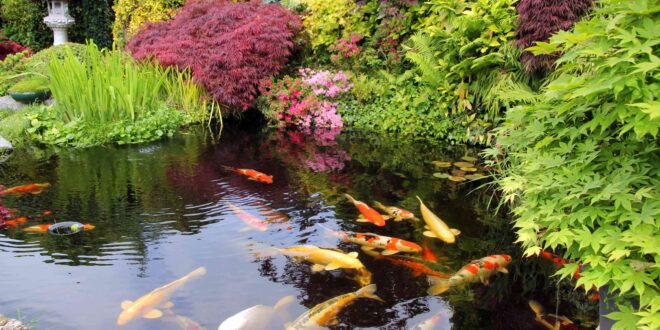Creating a koi pond in your backyard can be one of the most rewarding projects you’ll ever tackle. Picture this: the gentle sound of water bubbling, vibrant koi gliding gracefully through crystal-clear water, and a peaceful space to unwind. Sounds perfect, right? Let’s talk about how you can make it happen, even if you’re completely new to the world of ponds.
Why a Koi Pond?
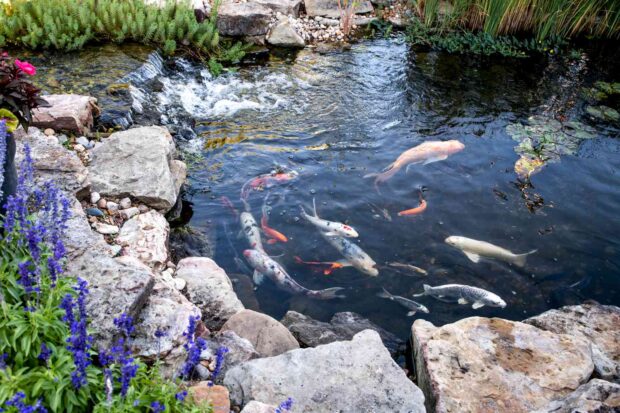
Before we get into the nitty-gritty, let’s think about why you might want one in the first place. Koi ponds are more than decorative features; they’re living, breathing ecosystems.
They can become the centerpiece of your outdoor space, a calming retreat, and a home for beautiful fish. Plus, there’s something magical about designing a space that brings life and tranquility to your yard. Watching koi swim can even be meditative, helping you de-stress after a long day.
For many, a koi pond becomes a way to connect with nature. It’s about more than just the fish; it’s about creating a harmonious environment where water, plants, and animals coexist. There’s also a sense of pride in knowing you’ve created something so beautiful and self-sustaining.
Planning Your Koi Pond
The first step is planning. A little foresight can save you time and headaches later on. With some patience and a clear vision, your pond will come together smoothly.
Choosing the Right Location
Selecting the right spot for your koi pond is crucial. Here are a few factors to consider:
- Sunlight Matters: Koi need sunlight, but too much can lead to algae problems. A spot with partial sun is ideal. You’ll also want to think about how the sunlight will change throughout the seasons.
- Accessibility: Make sure it’s in a place where you can enjoy the view. You’ll also want easy access for maintenance. No one wants to climb over bushes every time it’s time to clean the filter.
- Away from Trees: Falling leaves can clog the pond and upset the water quality. Keep it away from trees to make your life easier. Plus, tree roots can sometimes damage the pond liner.
Deciding on Size and Shape
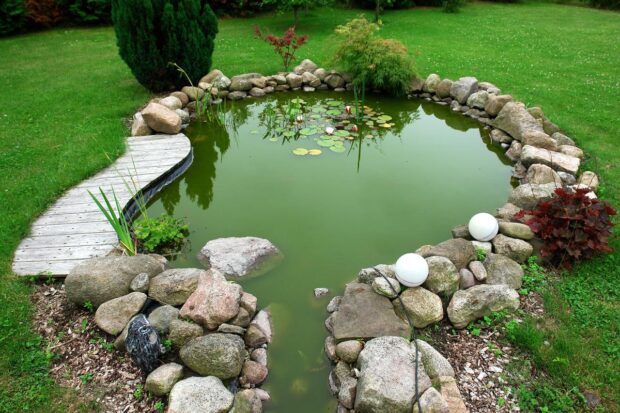
Think about how many koi you’d like to keep. Koi grow large, so a pond at least 1,000 gallons and 3 feet deep is recommended. They’ll need space to swim, and deeper ponds help regulate water temperature. Don’t be afraid to start with a smaller number of fish and expand later—your koi will appreciate the extra room.
When designing the shape, consider a natural, flowing look that blends with your yard. Avoid sharp corners and aim for curves, as this makes the pond appear more organic and can also improve water circulation.
Gathering Supplies
Before you start digging, make sure you have everything you need. Here’s a handy list:
- Pond liner: Flexible liners work well for most shapes.
- Underlayment: Protects the liner from sharp rocks and roots.
- Pump and filter: Essential for keeping the water clean and oxygenated.
- Skimmer and bottom drain: Helps remove debris and waste.
- Water plants: Create a natural filtration system and provide shade for the koi.
- Rocks and edging materials: For stabilizing the edges and adding a natural look.
- Test kits: Monitor water quality to keep your fish healthy.
- Aerators or fountains: Keep the water oxygenated and add visual appeal.
Having all the supplies on hand will make the process smoother and more enjoyable. It’s worth investing in quality materials to ensure your pond lasts for years.
Building the Pond
Now comes the fun part: bringing your vision to life!
Step 1: Mark and Dig
Grab a rope or garden hose to outline the shape of your pond. Once you’re happy with the design, start digging. Aim for shelves along the edges for plants, and make sure the bottom slopes slightly toward the drain. These shelves are great for aquatic plants and can provide hiding spots for fish.
Step 2: Install the Liner and Underlayment
Lay the underlayment first to protect the liner from punctures. Then carefully spread out the liner, making sure there are no wrinkles. Secure it in place with rocks or bricks. Be patient during this step; a well-installed liner is key to preventing leaks.
Step 3: Add the Pump and Filter
Follow the manufacturer’s instructions to set up your pump and filtration system. Position them where they’ll be easy to access for cleaning but hidden enough to maintain a natural look. If you’re unsure about the setup, consulting a pond specialist can save you a lot of trouble.
Step 4: Add Rocks and Plants
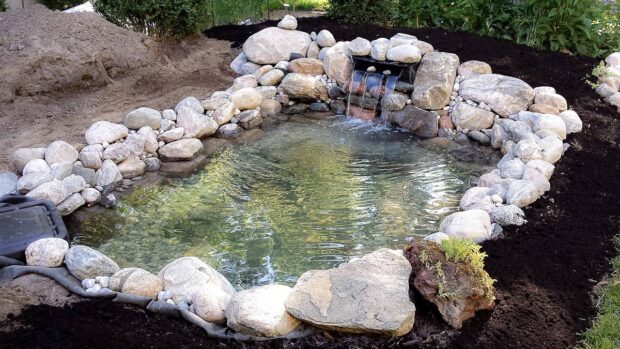
Use rocks to hide the liner edges and create a more organic feel. Water plants like lilies or lotus add beauty and help balance the ecosystem by providing shade and absorbing nutrients. Don’t forget to include submerged plants like anacharis for additional oxygenation.
Step 5: Fill with Water
Use a garden hose to fill the pond. Once it’s full, check for leaks and adjust the liner as needed. If you’re using tap water, consider adding a dechlorinator to make it safe for fish.
Step 6: Cycle the Pond
Before adding fish, let the pond run for a few weeks to establish good water quality. Use test kits to check pH, ammonia, and nitrite levels. Beneficial bacteria products can help speed up this process.
Introducing Your Koi
When your pond is ready, it’s time to welcome its new residents. Start small and gradually add koi over time. Float the bag of koi in the pond for about 30 minutes to help them adjust to the water temperature before releasing them.
Watching the koi explore their new home for the first time is an exciting moment. Each fish has its own unique personality, and you’ll quickly get to know their quirks.
Maintaining Your Koi Pond
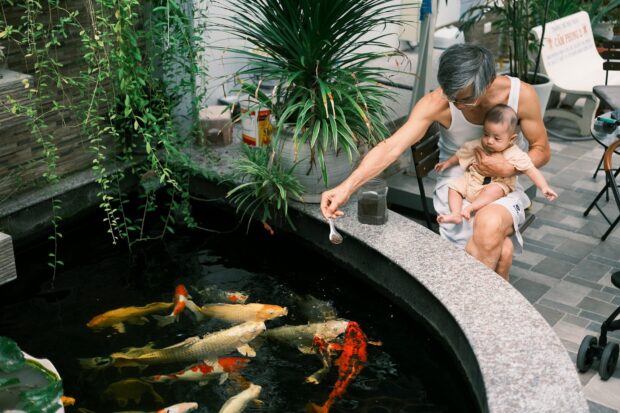
Keeping your pond healthy isn’t as daunting as it sounds. Here are some tips:
- Monitor Water Quality: Regular testing keeps you ahead of any issues. pH levels should be stable, and ammonia or nitrite should be near zero.
- Clean Filters: A clean filter ensures the water stays clear and oxygenated. Check them regularly, especially during the warmer months.
- Feed Koi Properly: Overfeeding can lead to poor water quality. Feed them just enough and remove any uneaten food. Koi can also enjoy treats like peas and watermelon.
- Seasonal Care: In colder months, consider a pond heater or aerator to prevent the water from freezing completely. During spring, perform a thorough cleaning to remove any debris that’s accumulated.
Enhancing Your Pond
Once the basics are in place, you can take your koi pond to the next level. Consider adding:
- Lighting: Subtle underwater lights create a magical effect at night.
- Waterfalls or Streams: Add sound and movement to your pond while improving oxygenation.
- Decorative Features: Statues, bridges, or unique plants can give your pond a personal touch.
Getting Help When You Need It
If the idea of setting up or maintaining a koi pond feels overwhelming, there’s no shame in asking for help. A pond specialist can guide you through the process and ensure everything is set up for success. Professional advice can save you time, money, and potential frustration.
The Joy of a Koi Pond
By the time your koi pond is complete, you’ll have a peaceful retreat that brings joy for years to come. Watching your koi grow and thrive is an incredible experience, and you’ll feel proud knowing you created a beautiful habitat for them. Plus, there’s no better way to unwind than sitting by the pond and soaking in the serene atmosphere.
Whether it’s for relaxation, the joy of caring for fish, or simply enhancing your yard’s beauty, a koi pond is a project worth every effort. So, grab your shovel and start building the oasis you’ve always dreamed of!
 Jewel Beat
Jewel Beat
